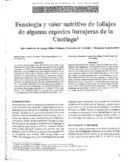| dc.contributor.author | Araujo Filho, Joao Ambrósio de | es_ES |
| dc.contributor.author | Carvalho, Fabianno Cavalcante de | es_ES |
| dc.contributor.author | Silva, Nilzemar Lima da | es_ES |
| dc.date.accessioned | 2015-03-19T21:35:19Z | |
| dc.date.available | 2015-03-19T21:35:19Z | |
| dc.date.issued | 2002 | |
| dc.identifier | 466716 | es_ES |
| dc.identifier.issn | 1022-7482 | es_ES |
| dc.identifier.uri | https://repositorio.catie.ac.cr/handle/11554/6317 | |
| dc.description | 2 ilus. 5 tab. 8 ref. 5 pág. | es_ES |
| dc.description.abstract | Los árboles forrajeros presentan diferencias estacionales en sus valores nutritivos que están asociados con variaciones en sus ciclos fenológicos. Se determinaron las fluctuaciones en el contenido de nutrientes y digestibilidad in vitro de la materia seca del follaje de siete especies arbóreas de la Caatinga y cómo se relacionan estas variables con su fenología. El contenido de nutrientes y la digestibilidad fueron altos en la fase de crecimiento vegetativo y disminuyeron fuertemente entre las estaciones lluviosas y secas p.ej., el promedio de digestibilidad de todas las especies decreció de 48 a 28 por ciento. Además, las diferencias en los constituyentes principales entre las especies fueron marcadas p.ej., en estación lluviosa, las concentraciones de proteína cruda eran 15-21 por ciento, lignina 7-12 por ciento y taninos 0,1 - 21 por ciento. Bauhinia cheilantha y Caesalpinia bracteosa fueron consideradas las mejores especies forrajeras para producir heno. Seasonal differences in the nutritive values of forage trees are associated with variations in their phenological cycles. Fluctuations in the nutrient content and of dry matter in vitro digestibility of the foliage of seven tree species of the Caatinga, and how these are related to their phenology, was determined. The nutrient content and digestibility were high during the vegetative growth phase, decreasing strongly from the rainy to the dry season p. ej., average digestibility of all the species decreased from 48 to 28 percent. Moreover, the differences between the species in the principal constituents were striking p. ej., during the rainy season, the concentrations of crude protein were 15-21 percent, lignin 7-21 percent and tannin 0,1 - 21 percent. Bauhinia cheilantha and Caesalpinia bracteosa were considered to be the best forage species for the production of hay. | es_ES |
| dc.language.iso | es | es_ES |
| dc.publisher | CATIE, Turrialba (Costa Rica) | es_ES |
| dc.relation.ispartof | Agroforestería en las Américas v. 9 (33-34) p. 33-37 | |
| dc.subject | FORRAJES | es_ES |
| dc.subject | ARBOLES | es_ES |
| dc.subject | DIGESTIBILIDAD | es_ES |
| dc.subject | EXPERIMENTACION IN VITRO | es_ES |
| dc.subject | VALOR NURITIVO | es_ES |
| dc.subject | CALIDAD PROTEICA | es_ES |
| dc.subject | FENOLOGIA | es_ES |
| dc.subject | ETAPAS DE DESARROLLO DE LA PLANTA | es_ES |
| dc.subject | BRASIL | es_ES |
| dc.title | Fenología y valor nutritivo de follajes de algunas especies forrajeras de la Caatinga | es_ES |
| dc.title.alternative | Phenology and nutritive value of the foliage of some forage trees of Caatinga | es_ES |
| dc.type | Artículo | es_ES |
| dc.journal.issueNumber | 33-34 | |


